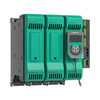Power controller in the holding furnaces for die casting
How to solve the non-linearity of the resistive value of the SiC heater with the power controller in the holding furnaces for die casting
GPC Power Controller
The GPC Power Controller allows to obtain a control system of the furnace die casting thanks to a three-phase load of Silicon Carbide (SiC) heaters, using the transformer primary and activating alarms and diagnostics in real time.
Thanks to the control of two phases for three phase load, cost advantages can be obtained compared to the 3 phase control. It also saves space in the electrical cabinet and reduces the heat generated by the thyristors.
Overview
- Accurate power control of Silicon Carbide (SiC) heater connected over 3-phase through a transformer
- Real time process alarms and diagnostic of power control unit
- Advanced power controller to form an integral and robust control system
The process
Low pressure die-casting (LPDC) is a metal foundry process of aluminium alloys along with magnesium and other low melting point alloys. Casting of aluminium or other alloys in the weight of a 2-150Kg (4.4-331lb) are a common feature like automotive wheels, blocks, manifold, aerospace castings, electric motors housing.
Compared with other permanent mould processes, LPDC provides low levels of scrap (no risers), high mechanical, metallurgical and technological properties.
The molten alloy (typically in the range of 700°C and 740°C (1300°F) is poured into a holding pressurized furnace located below the die table. A feeding tube, called riser or stalk tube, runs from the furnace to the bottom of the die. The surface of metal bath in the crucible is pressed by a dry air at relatively low-pressure (typically in the range of 0.1-1bar) in order to overcome the difference of metallic pressure between the die and the surface of the liquid alloy.
The challenge
To maintain the temperature of molten metal around 700-740°C (1300°F) in the crucible calls for Silicon Carbide (SiC) heater. SiC element material is brittle at low temperature which means at low temperature, an excessive amperage may cause electromagnetic forces large enough to fracture the element.
Because of non-linear and non-standard operating condition, power controller has to be intelligent and devised to operate factoring below conditions.
SiC resistance curve
The resistance value decreases approximately 3-4 time from 20°C (68°F) to 600-800°C (1112-1472°F), then increases 2 times up to 1600°C (2912°F) (Figure 2). Additionally, resistance increases with the aging and the ratio can reach 10:1.
Heater operating voltage 70-200 Vac
Require a transformer 380/480 Vac: 70/200 Vac
Predictive maintenance
Real time diagnostic of the heater and of the power controller to prevent damages, short circuits and consequent plant shut down.
Product benefits
Functionality of GPC
- Configurable SCR (Thyristor) firing method
- Configurable control mode to suit different resistance curve of heaters including current limit and power feedback
- Three phases with two or three legs control
- Connectivity: most commonly used Ethernet field bus
- Input signal: manual, 0-10V/4-20mA, via field bus
- Configuration of power controller through PC and/ or hand-held terminal
Various Diagnostic and Predictive maintenance
- Continuous temperature monitoring of power terminals of the controller via 12 embedded thermistors
- Heater break alarm and customised power control strategy for continuous power to heaters
- Monitoring of line voltage, line frequency, load current, load impedance and load power
Solution
GPC Power controller provides the required control mode of the SCRs and it drives primary of the transformer.
Power feedback and current limit control function
To keep the power transferred to the heater constant and also to protect the heater from excessive current flowing during initial period, soft start with current limit function is deployed. The line voltage is compensated for change of resistance over a period (ageing) through power feedback. (Figure 3)
Transformer control: Delay trigger
For the transformer to avoid the “inrush current” that initially can be 6 – 10 times the rated load current. A dedicated delay trigger feature inserts a trigger delay on the first cycle (as shown in the image below) in order to allow the exhaustion of residual magnetism.
Predictive maintenance
A problem such as loose cable connection can have serious consequences over time. If not properly controlled, the heat increases at the point where the connections could begin to melt or generate sparks that could ignite fire. Predictive maintenance provided with GPC allow to measure the over temperature on all power cables wire clamping in order to prevent dangerous situation.
Self-learning Heater Break alarm setpoint
HB alarm limit depends on the load type / connection and firing mode. Moreover, these thresholds can be different for each controlled phase.
- A Self-learning alarm threshold feature is available for an easy, quick and safe configuration.
- GPC automatically starts a current reading procedure with a list of power output % value and automatically set the suitable threshold.
Optimal configuration
The 2- leg control for three phase load (figure 4) offers cost benefits compared to the 3- leg control. It also saves space in the control cabinet and reduces heat generated by thyristors.





